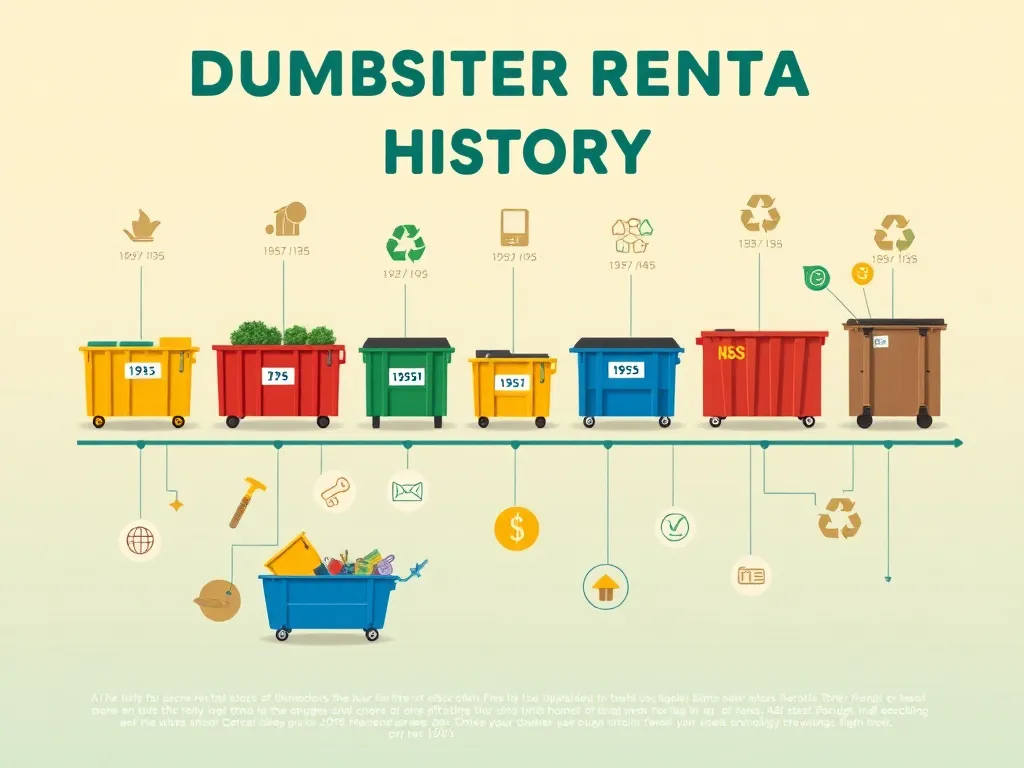Discover the Evolution of Dumpster Rental History

The Comprehensive History of Dumpster Rental
Dumpster Rental History traces back to a time when waste management was an overlooked necessity, but as cities grew, the need for efficient waste disposal became crucial. Initially, waste was thrown haphazardly, leading to dangerous and unsanitary conditions. The introduction of dumpsters was a game-changer, offering a systematic approach to waste management and defining how we deal with refuse today.
Over the decades, the concept of dumpsters evolved significantly. The transition from open waste pits to the modern dumpster rental system illustrates our growing awareness of environmental issues and the need for responsible waste management. This evolution gives insight into the societal changes regarding waste disposal, reflecting our priorities in urban planning and environmental stewardship as expressed through Dumpster Rental History.
Additionally, the Dumpster Rental History illustrates the impact of innovations in design and function, adapting to the changing needs of society. As industries flourished and populations surged, the evolution of dumpsters mirrored these changes, emphasizing how waste management is integral to public health and city infrastructure. This narrative reveals the intertwining of technology and society in addressing waste challenge through the years.
Furthermore, Dumpsters have been influenced by various regulations and policies designed to protect the environment and ensure safety in waste management. These regulations have shaped the Dumpster Rental History, guiding practices that promote sustainable waste disposal. Their presence in urban landscapes has paved the way for a more organized approach to handling refuse, thus showcasing the evolution of public consciousness surrounding waste.
In summary, understanding Dumpster Rental History is essential not just for waste management professionals but for everyone engaged in environmental concerns. This historical insight into how we’ve managed waste illuminates critical lessons regarding sustainability, urban planning, and social responsibility, shaping our practices and policies moving forward.
Understanding the history and evolution of waste management can provide valuable insights into the role of the modern https://en.wikipedia.org/wiki/Dumpster in our cities.
The Origins of Dumpster Rental
Early waste management practices can be traced back centuries, when civilizations relied on simple, rudimentary methods to dispose of refuse. This often included open pits and landfills, which were unsightly and posed health risks. As cities expanded during the industrial revolution, the necessity for organized waste disposal emerged, leading to the early development of dumpsters as we know them today.
The real breakthrough in waste management came with the invention of the dumpster in the 1930s by George W. Schaefer. He conceived the idea of a mobile, rolling container, which could be easily transported and emptied. This innovation led to the creation of a standardized size, making it simpler for businesses and municipalities to manage waste efficiently and economically, marking the birth of the dumpster rental industry.
World War II further accelerated advancements in waste disposal methods. With the war effort requiring streamlined processes for disposal of everything from food scraps to war materials, the need for efficient waste management systems became even more urgent. The military employed protocols that later influenced civilian practices, laying the groundwork for the modern dumpster rental service.
The Evolution of Dumpster Design
Over the decades, dumpster design has undergone significant changes, primarily in the materials used to construct them. Initially made from wood and metal, the advent of durable plastics and lighter metals in the mid-20th century saw a shift in design that enhanced durability and ease of use, catering to a diverse array of disposal needs.
Size variations of dumpsters have also evolved to meet specific requirements. Early designs were often uniform, but as industries grew, the need for different sizes became clear. Today, dumpsters can be found in various dimensions, each serving unique functions from residential use to large construction and demolition jobs, demonstrating adaptability to societal needs.
Innovations in dumpster technology have transformed rental services with the introduction of features like wheels, lift systems, and environmentally friendly designs. Smart dumpsters equipped with sensors that signal fullness to waste management companies illustrate the continuous evolution of dumpster technology. This innovation not only improves efficiency but also promotes sustainability in waste management practices.
Regulations and Laws Affecting Dumpster Rental
Environmental regulations have profoundly impacted dumpster rental practices. As concerns regarding landfill overflow and pollution emerged, laws were enacted to restrict waste types and promote recycling. These regulations necessitated a shift in how dumpsters were used, mandating greater accountability from rental companies in how they manage waste and ensure compliance.
Local zoning laws have also played a vital role in governing where dumpsters can be placed. These laws are crucial for urban planning, dictating dumpster locations to minimize visual blight and ensure public safety. Compliance with zoning regulations is essential for rental companies, impacting operational logistics and waste disposal practices.
Safety regulations in dumpster rental are significant, establishing guidelines for handling hazardous materials and ensuring the safety of workers and the general public. Such regulations include proper labeling of dumpsters, training for waste handlers, and clear instructions for users, ultimately fostering a safer waste management environment for everyone involved.
The Role of Dumpster Rental in Urban Development
Dumpsters play an integral role in supporting construction projects, acting as essential tools for managing debris. They facilitate quick and efficient waste disposal, allowing construction teams to maintain a clean and organized worksite. This function highlights the importance of dumpsters in urban development, ensuring that projects progress smoothly without environmental disruption.
The relationship between waste management and city planning is increasingly recognized, with dumpsters serving as a vital element in urban infrastructure. Proper waste management facilitated by dumpster rental services contributes to enhanced public health, decreased pollution, and a more sustainable urban environment, reflecting the centrality of waste management in modern cities.
Trends in urban waste disposal have seen a shift towards more sustainable practices, increasingly utilizing dumpsters for recycling initiatives. This trend has led to the proliferation of specialized recycling dumpsters, encouraging responsible behavior among residents and businesses, and emphasizing the growing importance of waste reduction and environmental stewardship in urban planning.
Cultural Perceptions of Dumpster Usage
Despite their practicality, dumpsters often bear a social stigma. Many people associate dumpsters with poverty or neglect, which can obscure their vital role in waste management. Efforts to change public perception are ongoing, aiming to elevate the conversation about waste disposal and sustainability.
Art and recycling have intersected with the culture of dumpster diving, where individuals salvage discarded items for creative projects or personal use. This movement highlights artistic expression and sustainability, challenging negative perceptions of dumpsters and fostering a more constructive view of waste.
Social movements have had a lasting impact on waste practices, advocating for reduced waste and improved recycling systems. These movements emphasize the importance of individual responsibility in waste disposal, shaping public attitudes toward dumpsters and promoting a culture of sustainability and conscientious living.
